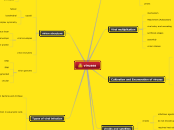viruses
Accelular Agents
viruses
virion
bacteriophages
eukaryotic viruses
viroids
satellites
prions
Viral multiplication
mechanism
Attachment (Adsorption)
viral entry and uncoating
synthesis stages
assembly
virion release
Cultivation and Enumeration of viruses
requires inoculation of appropriate living host
hosts for
bacterial and Archaea
agar cultures
animal viruses
tissue cultures
cytopathic effects
embryonated eggs
plant viruses
plant tissue cultures
plant protoplast cultures
viroids and satellites
viroids
infectious agents of closed, circular ssRNAs
do not encode gene
requires host cell
satellites
infectious nucleic acids (DNA / RNA)
encode one or more gene products
Prions
Proteinaceous Infectious Particle
Neural loss
virion structure
structure
size: 10-400nm
contain nucleocapsid (DNA and RNA)
Envelopes
capsid
helical
icosahedral
complex symmetry
viral envelopes
flexible, membranous layer
animal virus envelope
viral envelope protein
virion enzymes
virion genome
DNA
RNA
Segmented
circular
Types of viral infection
infection in bacteria and Archeae
lysogenic conversion
Archeae Viruses
infection in eukaryotic cells
cytopathic effects
transformation to malignant cell
viruses and cancer
tumor
neoplasia
anaplasia
metastasis
